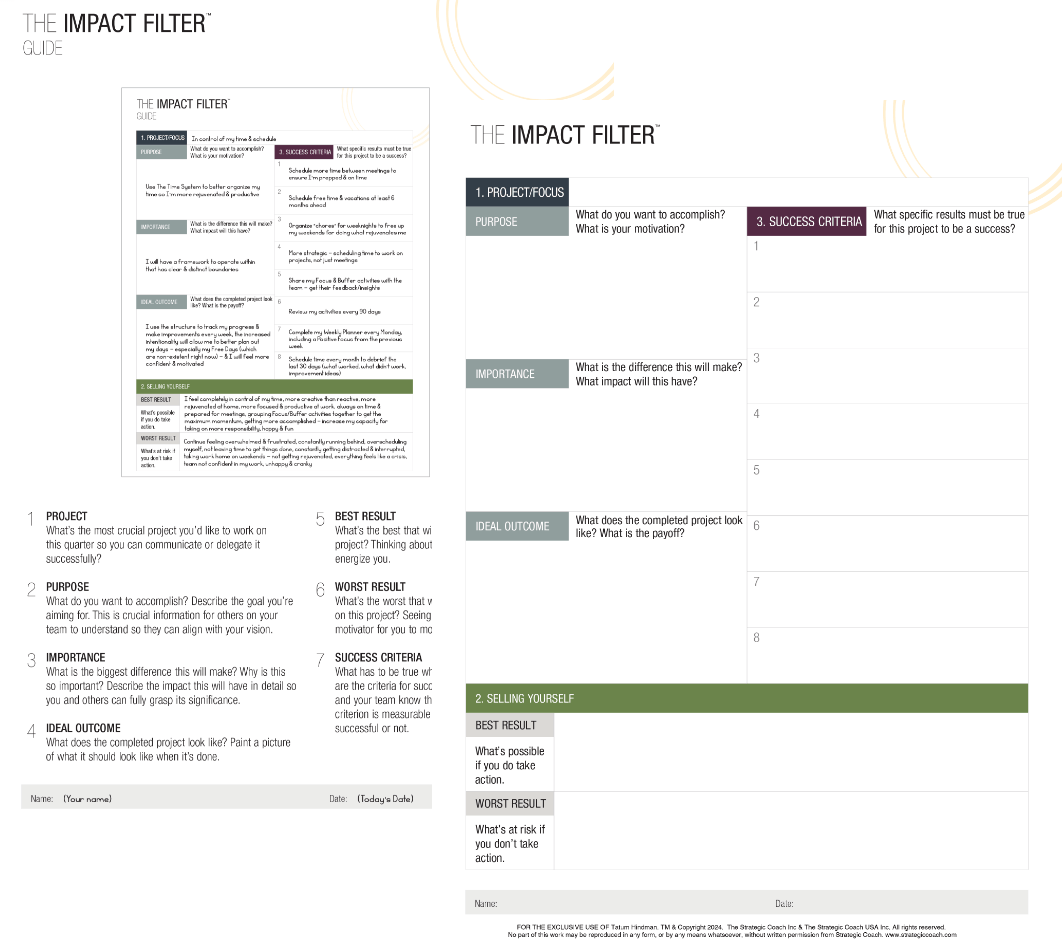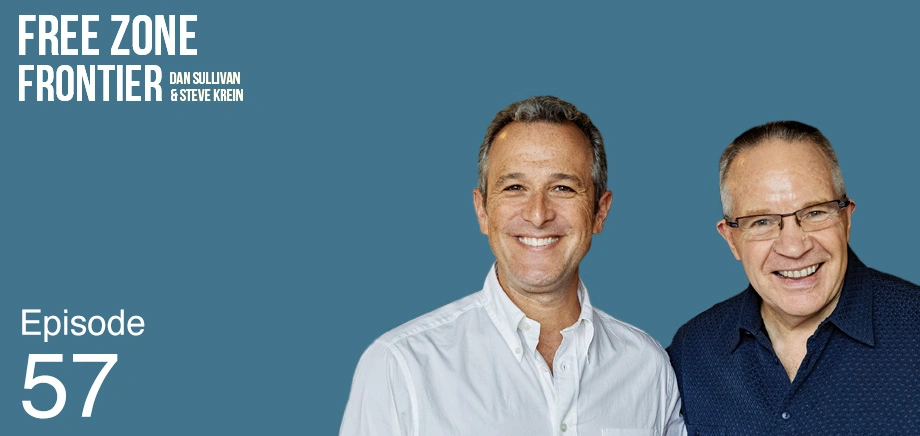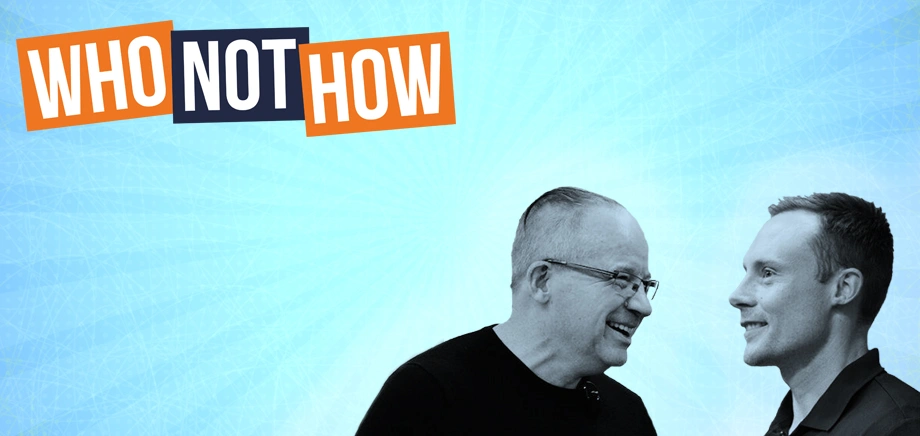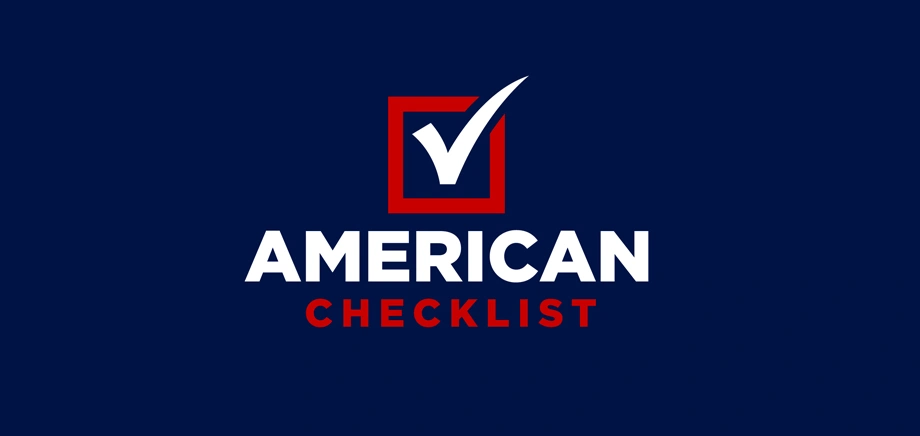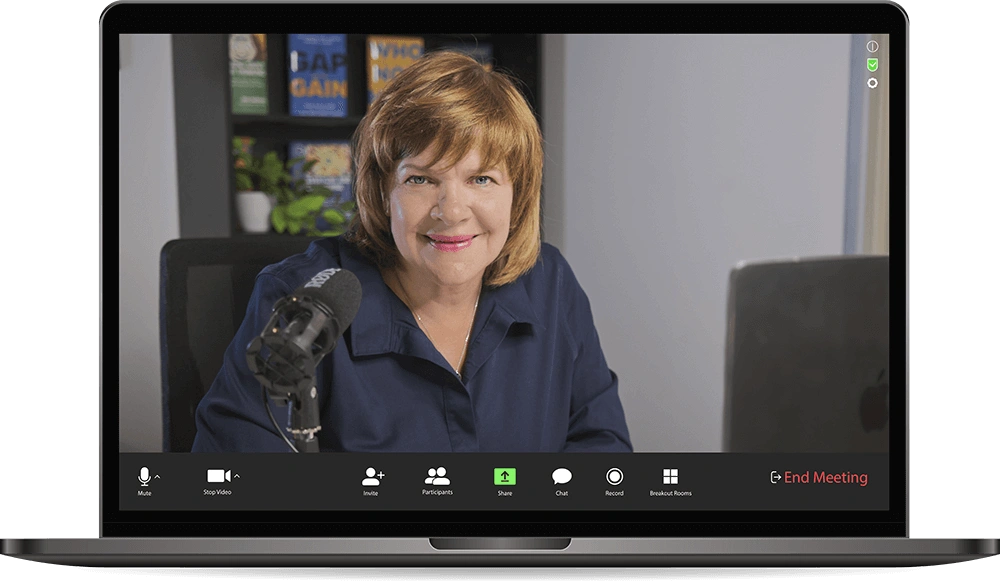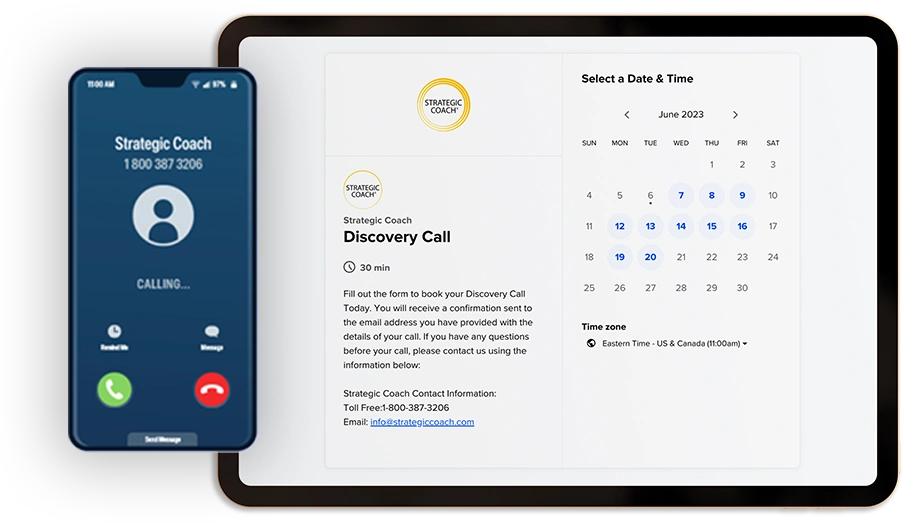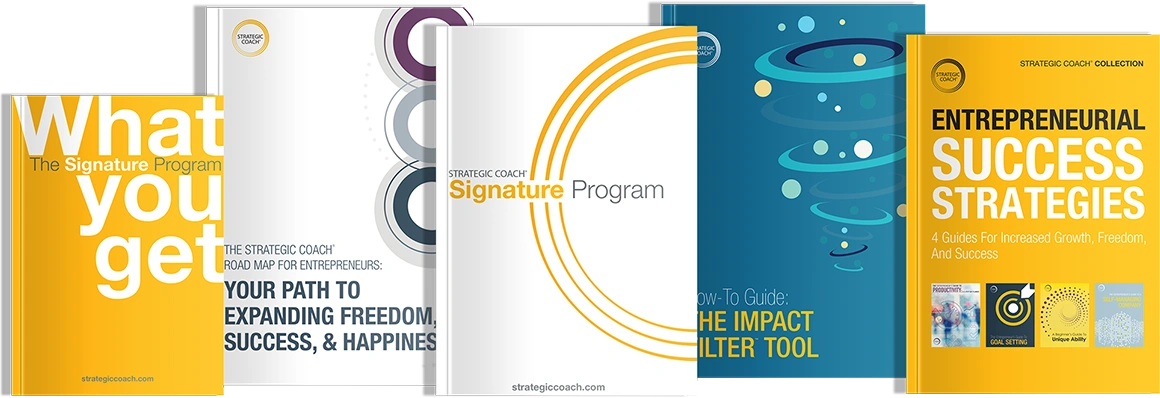Your Secret Weapon Is Discovering When You’re Great
March 19, 2024
Hosted By
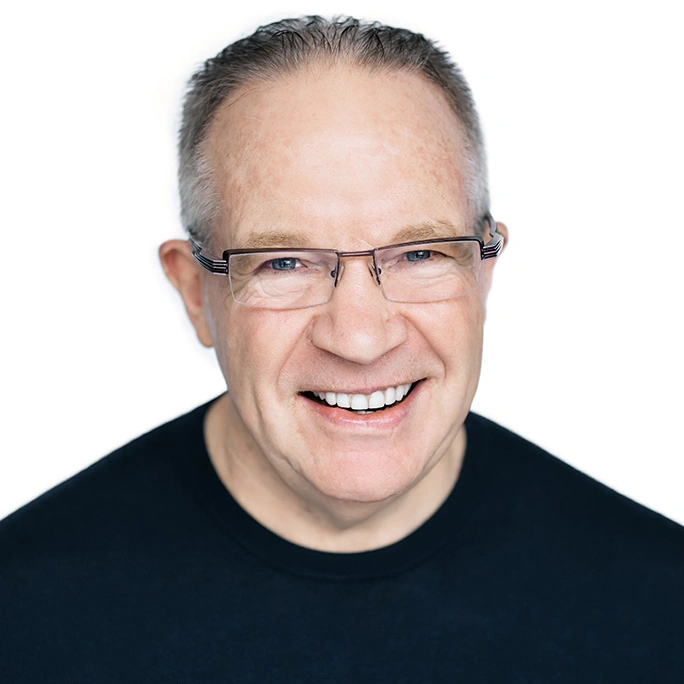 Dan Sullivan
Dan Sullivan
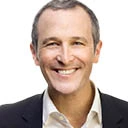 Steve Krein
Steve Krein
Dan Sullivan and Steve Krein delve into the power of the “When Are You Great?” tool, discussing how it serves as a crucial planning aid and a potent marketing resource. Using real-world examples, they explore the implications for crafting compelling offers, narrating impactful stories, and leveraging a marketer’s secret weapon.
Highlights:
To figure out what gets talked about, you have to combine everything you’re telling with everything you’re being told.
You share when you’re good because you have competition. Others share when you’re great because they don’t think you have any competition.
Saying when you’re good is trying to make a convincing argument. Being told when you’re great is your compelling offer.
How you're making people feel transcends what you do for them.
Your messaging should include both what you do and what happens when someone participates in it.
Measuring impact is hard in the short term, but unavoidable in the long term.
Resources:
The Self-Managing Company by Dan Sullivan
The Strategic Coach Entrepreneurial Time System®
The End of the World ;is Just the Beginning by Peter Zeihan
Episode Transcript
Dan Sullivan: This is Dan Sullivan and Steve Krein, and we're doing a podcast on a tool from Strategic Coach called When Are You Great? Okay. And Steve, what triggered this idea for a tool was just a phrase that I picked up and, you know, sort of like little phrases might be in the Wall Street Journal, but it was from Walter Payton, who is a great Hall of Fame running back for the Chicago Bears. What the phrase was, is when you're good, you tell everyone. When you're great, they tell you. Okay. And it just struck me as an important distinction. So that's where this whole thing began. So I said, well, what are we telling people? What are the good things that we're telling people? What are you telling them? And I went through, and this is straight out of our membership sales presentation. This is what our salespeople talk about. For example, Lifetime Growth process for talented, successful, ambitious entrepreneurs who are looking for their next 10x jump, who want greater freedom of time, money, relationship, and purpose, who want a Self-Managing Company, who want to attract and retain committed and competent staff, and who want to repair the damage that they've done to their family and to their health and start enjoying their success. So I would say that. And usually, if you're talking to the right person that gets their attention.
Steve Krein: So I have a question as you think about your, I think articulation of almost like the right fit customer or client that you've identified so that not only does your team, your sales team, and your team members across the company understand who you're looking for, with precision by the way, but people can self-identify as you're talking about the things that they want. And I'm fascinated by the distinction you're making between that just being when you're good and now when you introduce this idea of what they're telling you when you're great, I think it's an interesting juxtaposition of, my question I was going to ask you was like, why not tell people what they're telling you versus what, you know, continue telling them what you've kind of identified as the right fit client?
Dan Sullivan: That's a good question. Because when I did it in the workshop, the Free Zone entrepreneurs, and I've done it in two workshops, so it works really well. After they've done the left-hand column, you're good, what are you telling them? And the right-hand column, you're great, what are they telling you? I said, how many notice that there's a real distinction between the impact of these statements? How many of you just emotionally you can feel that there's a real distinction? And I'll just take one from the great side, and we get this a lot. Strategic Coach transformed my personal life, my whole approach to my business, and my whole appreciation for my success until now. Okay. Well, that's a really different kind of statement than, you know, we create a lifetime growth process for talented, successful, and ambitious entrepreneurs. One of them is more factual, the other one's very emotional.
Steve Krein: You know, it's funny, because as I look through this list, I could be reading you this list of why you're great, right? To me, it's almost like why they come and why they stay, right? So you hear these things on your left and you're like, oh, those are the things I'm looking for. That's what I want. But then the truth is you have transformed my life and my whole approach to business, my whole approach to my development of my family, my relationships, my health, all those things. I look through the list of things you've got here about greatly expanding ambition for future success. I've been in the Program over 25 years now, and I think about how positive batteries-included and how energetic I am to other people as a result of the, I think, plug-in that I get every quarter or every time I join a Connection Call or do any of these things to feel surrounded by other people. who are creative, who are growth-minded, who share, I think, a lot of the things that you outlined and what you said on your good side. So it's interesting. These are the reasons to stay for 25 plus years in a program that offers the things that you outlined, which are items that are factual but yet not emotional.
Dan Sullivan: Yeah, one thing that came out in the conversations, I mean, I'm just sort of reporting back on just people's response to this thinking tool. They said, why am I not saying the things on the right-hand side? And I said, well, I've got a question for you. If you tell people on the left-hand side all the bullet points that you have there, how many people tell other people about this? We had discussion around it. People said, nobody passes on that information to anyone else. And I said, but what about the right-hand side? Do they share this with everybody? And they said, they share this with everybody. And I said, you know, If you don't have anything written on the right-hand side, marketing is not your problem. So what I got here, that actually in truth, what gets talked about, both telling and being told, you have to combine those two sides. Not that one replaces the other side, it's that you have to combine the two sides.
Steve Krein: Yeah, it reminds me of goal and result. You know, when you think about your goal, might be I'm looking for greater freedom of time, money, but like the result ends up being greatly expanding your future success, your personal success, your relationship success. So it's an interesting thing. So you're looking at it going, no, it's not about which one. It's about combining both sides. Yeah. Yeah, it's interesting.
Dan Sullivan: Well, the big thing is that you're saying this stuff on the left because you are, in fact, in competition. But they're saying the things on the right, because they don't think you have any competition.
Steve Krein: Yeah. So is one the how and one the why? Like, it's an interesting combo. And I'm actually interested in, have you brought this back to your sales team and talked about how this would affect, if at all, the marketing materials or the sales conversations?
Dan Sullivan: Just starting that process, because I wanted to test it out for a quarter in the workshops. I mean, I don't test anything out on my team members because I'm writing checks to them. I do test them out on people who are writing me checks. You know, that's the whole thing here. But I would say that the other thing about this is that on the left-hand side, you're trying to make a convincing argument. But on the right side, you're being told what your compelling offer is.
Steve Krein: Yeah, it reminds me of, there's another saying about, people don't remember what you said, but they remember how you made them feel. And what's interesting is when I do talk about, you know, I'm reflecting both on my experience in Strategic Coach, what I hope is the and believe is the experience that entrepreneurs have in StartUp Health. And I think the idea of how you're making people feel transcends what you do for them. Or at least say, people often forget what you did for them or can't articulate exactly what you did, but they do remember how you made them feel and whether that be supported, empowered, whether it be more freedom, whether it be the ability to feel like they can achieve what it is you're telling them. It's just a very interesting way of almost curating out the list and not making it one or the other. But I like your thinking around both of them. That wasn't how I thought about it when I first heard the idea of when you're great. I always think about it as levels of when you're good, you're here, when you're great, you're here. But I love this idea of introducing both together in parallel. Big difference.
Dan Sullivan: Yeah, and I think that the more you make them interactive… It's not versus each other. No, it's and. It's really and. I mean, there is something if they don't know you that you have to have some statements, you know, that describe what the process is that they go through. But on the other hand, it's very, very crucial to get statements and get life experiences that are communicated that kind of tell you what the impact on the right is of everything on the left.
Steve Krein: OK, so now I'm going to bring up something we were talking about before we started recording the podcast, which is measuring impact. We were having this conversation about, I can say with Peter Diamandis brought up about impact. And I live in a world where we do talk about long term impact on Alzheimer's disease or type one diabetes and the different things that our companies are working on solving. And you talk about it's hard to measure impact. But what you just have on this right-hand side is impact. It is impact on people's lives. It's not the idea that you spend a day every quarter going to Chicago or Toronto to spend time in a workshop and you meet good friends and you learn new things and you stretch your thinking. It's actually you're transforming people's lives. You're helping expand their ambition. You're helping them be a more positive force of energy around their friends and family and team members. So there is a big impact here. And it's question is, is it measurable? And you brought up the question, can you measure impact? Or how would you measure impact? How would you measure impact? And I think it's an interesting column of items that are all impact driven.
Dan Sullivan: Yeah. I learn a lot from people's interaction with the thinking tools, and that's how they get improved, and that's also how new thinking tools get created, is an interactive discussion with what their actual experience is. And I'm getting a lot more of it these days of the right-hand side, because this is what they are telling other people who are attracted to find out about Strategic Coach. I haven't come across anybody who really talks about this stuff on the left-hand side in a laudatory way, because they don't really remember that stuff. They only remember their own experiences.
Steve Krein: Yeah. The other thing you mentioned about your own thinking structure is, what do I need to do this quarter? And what do I need to present in the workshop? What's the tool? How many clients are coming? How many new clients have signed up, et cetera? So you're only looking one quarter at a time, right, in the next 12 weeks. But is there something to be said about what you're delivering today and what over time is the long-term impact of the compounding nature of these quarters. Because if you look at any one of these items, Dan, right, if you go, I could teach you in a workshop, I mean, I could experience in a workshop as a client or as a member in your community how to have a Self-Managing Company. That's why I show up fascinated by the tools and the framework and the whole thinking around it. Now, that's kind of like what I want today. But what the result is, is kind of on the right side, where what you get from having a Self-Managing Company. I'm just digesting some of the way this tool's laid out, the shortcut is laid out, to kind of stretch my thinking about how to, both how to digest it, but then also how to think about StartUp Health. And I'm thinking and putting my own lens on what we're telling people also.
Dan Sullivan: Well, here's the thing about it, you're in a situation now where you can do a 20-25 year test run on this idea. Because you're just putting together now a global network of medical specialists in the area who are devoted to curing Alzheimer's or preventing Alzheimer's. And I would say that this is a nice thing to start with is that you've got all the experience of all the other moonshots, the other moonshots that you've been working on ever since you started StartUp Health, okay? So you've probably got a good set of bullet points on the left-hand side, but just what it means to be in the StartUp Health global community, you know? So you've got the bullet points there, but you're at the position now where the experience that you can focus on immediately is really the one that you mentioned when we were just getting ready for the podcast. You mentioned that I brought together, and I thought I might have 20 people, but I could have 60 people. And that's the they who are telling you great things, okay? Yeah, that's one level of the value that's being created by your moonshot. The other level is they being aware of their own left-hand side and right-hand side regarding their client base, you know, who they want to be a hero to. OK, so you got a double level what their experience in the community is. But the other thing is what the value is being created by their particular approach out in the marketplace.
Steve Krein: Yeah, you know, it's an interesting way to begin to curate what I think you have to have in your messaging about what you're delivering. And then the word testimonial is coming up in my mind as I'm thinking about the hundreds of testimonials we have that often don't mention the commodity or tactical stuff that you said, like a workshop or showcase. It's like things that we do that are the product names of things that we do for that, you know, that we have listed on our website or in the materials. But the testimonials are far more emotional. They're far more articulate around the impact that we have. And so it's an interesting way to kind of bring testimonial, you know, cause I do think testimonials oftentimes, especially ones that are recorded versus written, you can feel that energy coming out on the impact you're making on people's lives, your client or members, or in our case founders lives.
Dan Sullivan: Mm-hmm. And then in the course of the exercise, we say, well, you got a lot of things written down at the top. And what I'd like you to do is sort of consolidate the three best on the left-hand side and consolidate the three best on the right-hand side. And what I suggest to them that that should be the heart of their ongoing experiential development of the value that they're creating in the marketplace is both sides. You have to tell them what you do, but you also have to tell them what happens when they participate in this.
Steve Krein: What you do and what happened. So this has been out for a couple of months, right? How long have you been using this tool?
Dan Sullivan: Three months? Yeah, since December. That was the beginning of the quarters. It was December and January. So we just wrapped up a couple of weeks ago for that quarter’s workshop.
Steve Krein: So what are some of the stories that you've heard anecdotally from the Free Zoners about what they've done with this kind of thinking? This is a very interesting deep dive, which I don't think we've done in a while around your client base or your member base or your customer base, that I think really does touch on slowing down and making sure that you're articulating the factual and the emotional together, not only your marketing material, but your own thinking about your program or your system or whatever it is you're doing for your clients.
Dan Sullivan: Yeah, and it seems to me that from our standpoint, internal at Strategic Coach, is that are we actually communicating and being communicated to that matches this list? It focuses your mind to be much more, what I would say, systematic about capturing people's experience to see if it actually resonates with what people have already told us. And that gives you sort of a quality control. But the other thing is, are you clearly articulating what people can expect. And I think it's on the left-hand. This is what you can expect as the experience that we're providing to you. But on the right-hand side, we want to also hear about and we also want to capture what you are experiencing when you're not in the workshop, you know, in the 90 days between workshops. And I would say, I didn't think about this before we started the podcast, but you just told us about the amazing impact of just putting together this community in the world of Alzheimer's scientists, researchers, doctors. And it just seems to me that this is a good starting point for you, because clearly you have in mind 25-year framework. But how do you get evidence, week by week, quarter by quarter, that the things that you intend for the moonshot, these things are actually happening?
Steve Krein: So what's interesting, Dan, is I'm going to also pull back that comment you made earlier. You said, I don't know how to measure impact, but I know how to measure a lot of the data that you get each quarter. Impact short term is hard to measure. In the quarter you're in, or the day you're in, or the week you're in. But when you compound it long term, it is unavoidable. Because if there was no impact from the things that you're doing this quarter, and then the last 100 quarters, the last 200 quarters of time that you spend with the entrepreneurs in Free Zone or in the 10x program, any of the people that you've gotten to know over the last quarter century plus. But when you put it all together, it's hard to avoid that there's impact. And you wouldn't have as big of a client base as, I want to go back to fan base, not even client base, like people who are passionate about what impact you've had on their lives, they wouldn't show up every quarter for the things that you can measure every quarter. You can't measure short-term impact, but you can measure long-term impact. And the things on that right side, Dan, are the impact you're making on people, entrepreneurs all over the world.
Dan Sullivan: Yeah, but it goes back to the saying that your eyes only see and your ears only hear what your brain is looking for. So I think a lot of entrepreneurs are looking for evidence that supports the left-hand side. They're disregarding or not taking seriously the evidence that's showing up on the right-hand side.
Steve Krein: Yeah, I'm not seeing it as short-term, long-term. I'm seeing it as what you do, how you make them feel. There's a whole bunch of synonyms here, right, that you could keep going down if you go down left side, right side here, that I think are important. You always talk about zero and one, the binary nature of everything. I think there's something very powerful about connecting the long-term to the short-term. Yes. Really powerful and not only long-term and not only short-term. Because if you only talk about the long-term impact of showing up every quarter and learning the shortcuts and being a part of the community is going to have, if you only talk about long-term, I don't think people can touch that and feel that and understand that. Okay, what do I have to do today? And on the flip side, if you just keep focusing on short-term and you don't know where it's going, that's dangerous also. So I think there's a nice marriage here of a number of other things that you can use to get value out of this tool.
Dan Sullivan: Yeah. So let me ask you a question. You just got introduced to this in the last hour. Right off the bat tomorrow, just talking about the team at StartUp Health, is there something that you would do that would be a change of approach to how you're positioning yourself in the marketplace just to attract people in, but to position yourself with a particular community related to one of the moonshots.
Steve Krein: Yeah, I mean, what's incredibly timely about going through this shortcut today is that we're in the midst of the launch of this Alzheimer's moonshot. We announced it four weeks ago, and we've had a surge of interest of people, founders, academic founders from all over the world, Alzheimer's and related disorder-focused founders and research teams working on a next generation of innovation who were immediately taken by the idea of joining a community of other like-minded innovators. And coupled with getting an entrepreneurial education, coupled with getting access to a network of mission-driven funders, and the whole host of what I would say was listed in the press release as all the elements of the moonshot, right? We've got this community, we've got this program in Health Transforming University that's going to help them learn how to talk and act and think like an entrepreneur, and then become sustainably funded. You know, that's all the stuff on the left, what we're telling them. But when I look at all the founders that have been a part of StartUp Health for the last 10, 12, 13 years and the impact that we've had on their lives and their companies and their organizations and their dreams come together. And I think for me, this is going to help me articulate much better to these new founders coming into the Alzheimer's moonshot, what they can expect long term and what we're hearing from other founders who've had the chance to be a part of this community. So for this whole new generation of Alzheimer's founders, it's going to be brand new to them. What this even is, even the idea of being a part of a peer community, a global peer community, of dozens and dozens of Alzheimer's founders is a new concept for them. But the impact that it's going to have, I think, is going to be over time, not something they're going to have day one. It's going to be something they're going to feel maybe the potential for, but is only realized over time.
Dan Sullivan: I'd just be interested in you as you move forward. I mean, you're four weeks into a new venture, really. It would just be interesting how you use this tool to keep yourself constantly grounded and confident as you just progressed, because most people don't have a 25-year framework to operate. And one of the real problems with long-term frameworks is that how do you keep your confidence up on a daily basis?
Steve Krein: Yeah, well, you know, it's interesting. So I hadn't really thought about until you just mentioned this idea of how to keep it up on a long term basis. We're a year into our type one diabetes moonshot. We launched it last March. We now have 31 founders in a community. We told them, go back to what you're telling them, we told them what the program is, what the community is about, how it's working. That's why they joined. And now what they're telling us, you know, some of them have been in a full 12 months, some of them been only in for six months, some of them for three months, but we got to 30 of them at the end of the year. What they're telling us is about the relationships that have been built with other founders, that the unique access that they're now getting to mission-driven funders and partners. And so what they're telling us now over the past year and what we told them a year ago is a great setup for us to illustrate to the Alzheimer's founders what they can hope to experience as well. So it's a really good sales and marketing tool, if you will, for describing this. And then if I go back even longer than a year, I start thinking about the 500 companies over the last 12, 13 years, what we told them and what they're telling us and how I think it's a great exercise to start to organize the thinking and the internal discussion about it.
Dan Sullivan: You know, I mean, I'm always experimenting and I have a creative relationship, you know, at the Free Zone level with about 100 Free Zone entrepreneurs. And then with the 10x, I'm retaining my two-hour connections with the 10x. I mean, my original thought is that I would just do it during 2023, as the transition was made that we would have other coaches, five other coaches, coaching the 10x Program, and that was achieved. But I found that my having two two-hour workshops a month, so six and a quarter, with the 10x, it gave me an opportunity to take tools that I'm developing at the Free Zone level and seeing if it is meaningful to people at the 10x level, and we've discovered that they all are. But it also, I make a point in the two-hour sessions, you know, that the material I'm showing you is actually Free Zone material, okay? And we've noticed a real quickening of the cycle in which people decide, okay, I'm ready for Free Zone. But we're also pulling people up from the Signature Level. So I've got these three Signature 10x in Free Zone. And I'm noticing that my being there in just these 6 times 2 hours, 12 hours a quarter, is having a profound impact on the movement of people from the bottom level to the middle level to the top level. So I extended it to the end of 2024, and I already know in February that I'm going to do it in 2025. In the course of the year, you have two or three hundred 10x people who are attending at least one of these. Some of them attend twenty-four a year. They would be there, and they're getting more time with me in these two-hour sessions than they would ever get just doing their quarterly workshop with me.
Steve Krein: I just realized that this was done almost on either the Signature Program or the 10x. This is not done on the Free Zone, or at least the worksheet that you filled out here was not done on the Free Zone. It's an interesting thing to think about. Okay, so you've got your Signature Program, your 10x Program. This is what you're telling them and what they're telling you. If you go to the Free Zone, what you're telling people about what Free Zone is and what they're telling you also is another level of taking a couple of different parts of what you're selling in the market and taking it through their own experience versus as a company. I hadn't thought about that either.
Dan Sullivan: We're doing a collaboration with John Bowen in Free Zone, and he bought a research company out of Chicago. So John has a premier coaching program for advisors to wealthy people, really, really successful, affluent advisors who are financial advisors to mainly families, really wealthy families, you know, family office type of situations. So he said, you know, I'd like to do a survey of entrepreneurs, and we'd be very, very pleased if a considerable portion of the entrepreneurs were Strategic Coach entrepreneurs. We have our own that we can put together. So it turned out 1,300 of his including advisors and their clients. And then we had 800 of Strategic Coach clients, both current and what they call alumni. There is no such thing as a strategic coach alumni, but I went along with it. So they had a whole period of questions that were very specifically financial structuring, financial processes, financial advice, and they had about 16 questions related to how people were doing. And then there were about 12 questions of ours which related to, yeah, but is any of it making you happy? So Free Days, how much free time do you take? What's the quality of your relationship with your family? What's the culture of your team that you put together? So I looked at everything that would be easy for Strategic Coach clients to answer because it's what the program is all about. So we got the survey back and it's massive. I mean, it's got about 150 pages. It's a massive survey. Then what they did for us was broke out the contrast between Strategic Coach entrepreneurs, the 800, and the 1300 others. And it was stark. The difference was stark. And I'll just give you three that really impressed me. Optimism about the future. So with the non-Strategic Coach clients, it was very low. It was like 5% of the 1300 were optimistic about the future. With Strategic Coach, all the current clients, it was 95%, and all the Strategic Coach people who had been in the program, it was about 50%. It was just stark, the optimism about the future. The second one was, what's the relationship between work time and non-work time, you know, time off? And it was stark that Strategic Coach clients make more money and spend fewer hours doing it than the general population. The other thing is, how long do you think you're going to live? And that's where it became, they said, we've never seen differences in any survey that's as great. So 90% of all the Coach clients think they're going to live more than 90 years, where the others, it was about 25%. Then over 100. The Strategic Coach clients, it was about 45 to 50 percent. Over 110, it was about 34 percent. On the other side, it was barely any response whatsoever.
Steve Krein: So there are 100 questions, and these were the three that had the starkest differences?
Dan Sullivan: No, there's about a dozen, but I went after those because they're very dramatic.
Steve Krein: First of all, it's interesting because if you look at the what they're telling you column in here, some of that kind of shows up right there, right? With their energy, with their relationships, with their optimism. By the way, we should do a whole podcast on optimism versus pessimism, or optimistic versus pessimistic people. And I want to double click on that for a future episode. It's coming up a lot.
Dan Sullivan: Yeah. And the reason is we're going through probably one of the biggest seismic shift periods in the next book, quarterly book, and it's called The Great Meltdown. And it's my synthesis and simplification of what I've learned from Peter Zion. And his main tools for analyzing the future of any country over the next 30, 40 years is, what is your geography and what are your demographics? So that's always been his two things, that who you are as a country and what you can expect for the future, you combine where in the world you're situated. And the second thing is, what's the makeup of your population? And the key spot is, how many people do you have between 20 years old and 50 years old? Because that's the productive generator. That's the profitable generator of any population. And then, how many new babies are being born, because that predicts 20 years down the road, how many 20-year-olds you're going to have. Okay, so that's the general thing. And I've read the last book of Peter Zahn's great book, The End of the World Is Just the Beginning. He said that the world situation is just a function of what the United States is deciding to do with its future. And he said that's what created the global world after the Second World War. The United States says, you know, we just didn't want to get involved in any more European wars where we have a lot of coffins coming back with young men in it. We just don't want to do that anymore. So what we're going to do is do a deal with the world where we're half the world's GDP. In 1945, the U.S. was half of the world. And we got a lot of money, and we're producing a lot of stuff. And what we're going to do is that we're just going to lend you any amount of money you want so that you can create your own manufacturing industrial economy, and you can make products and you can sell them into the United States, no tariffs. And not only that, but our Navy will protect all the trade routes. And final thing is everything's going to be in U.S. dollars. OK, so that was the deal. They put that together. 1945, all the countries that became the global world afterwards signed on to it. But it only had a reason. That was not to get involved in a land war with the Soviets. They don't want to get involved in a land war with the Soviets because the Soviets just throw bodies at the problem. They don't care if they lose a million people. They don't care if they lose two million. And the U.S., you don't sacrifice taxpayers that way. You don't sacrifice consumers that way or workers. You just don't do that. And it worked, it worked superbly and it created an amazing world. But in the American mind, it was only up till 1992 when the Soviet Union quit. They just basically quit. But the rest of the world, it was such a sweet deal that they went on thinking that the deal's in place. And the U.S. has been rethinking this. It's not any particular president. It's been started with Clinton, went to Bush, went to Obama, went to Trump, went to Biden. And they're all saying, let's come back and, you know, essentially take up our country. This shifts everything in the world. From my standpoint, I've read the book, I said, this shifts everything in the world. And what's crucial to the future for the next 30 years, and this is where my great meltdown idea comes from, that what I understand that the constraints that any country, any group of people, any individuals operate under. But basically what I got to is that there's four factors. It's the, at any situation, and this is hourly, daily, is the constraints that you have are controlled by the cost of money, how much money costs, interest rates, you know, investments, how much it costs. The other thing is the cost of energy, cost of labor, and the cost of transportation. And if you compare countries around the world, all the countries are really at the bottom with those four costs, or they're all grouped together in the middle. And there's one country that's way out by itself, and it's the United States. The United States has the greatest ability to control its four melt costs of any country that's ever existed. And the U.S. is just reviewing what if we're dealing with you as another country, to what advantage? Because we don't have to worry about the military situation anymore. I mean, there's always opponents and there's always enemies, but it's not really high on the American agenda. So I wrote this whole book and I said, what keeps the cost of melt money, energy, labor, and transportation is entrepreneurship, innovation and entrepreneurship. You guys have a constant army of innovators. Of innovators working on the future. Yeah, and they're doing it for their own reasons. But the best stadiums to compete in are these four melt costs. Are you keeping the cost of money for your clients and customers? Are you keeping the cost of money, energy, labor, transport? So, I mean, it's just really interesting. But my sense is that you will not innovate if you're not optimistic about the future.
Steve Krein: You're paralyzed. That's a great topic. Let's park that, wrap up. What's your biggest insight from today's session, Dan?
Dan Sullivan: Well, it was a great opportunity to talk with you about this tool, because it filled up the time in the workshops, but I never had anyone to just sit down and talk about on a deeper level, and I know you always have great insights and questions. So I've learned a lot about this, but I'm thinking about that this is a great planning tool.
Steve Krein: Yeah, it's a terrific planning tool. My big takeaway is it's a great marketing tool to prepare your copy and to prepare your messaging and to even organize testimonials in a way to make sure that you're not just telling them what you know is going to be of value, but you're sharing what others are telling you. And I think that combination of matching a convincing argument with a compelling offer, not one or the other, together, is what I think ultimately enables you to discern when you're good and when you're great, and how impactful it could be as a sales tool for explaining what you're doing to help entrepreneurs achieve whatever it is they're working on for us, solving the health challenges for you, greater freedom of time, money, purpose, and relationships. Yeah. Excellent. Yeah. All right. Look forward to digging in, Dan, for the next episode.
Dan Sullivan: Thank you, Steve.
Related Content
The Impact Filter
Dan Sullivan’s #1 Thinking Tool
Are you tired of feeling overwhelmed by your goals? The Impact Filter™ is a powerful planning tool that can help you find clarity and focus. It’s a thinking process that filters out everything except the impact you want to have, and it’s the same tool that Dan Sullivan uses in every meeting.
